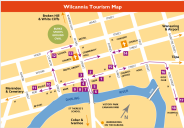Wilcannia - historical facts and figures
Wilcannia was first settled by Europeans following the exploration of the Darling by Major Thomas Mitchell. The rest stop on the Barrier Highway on the Cobar side of town, commemorates one of his survey points.
The original settlers were pastoralists who took up “runs” that were millions of acres in size. Wilcannia is in the area that is the homeland of the Barkindji people. “Barka” being their word for river.
The Barkindji was a group of tribes that ran the length of the Darling River from Bourke to Wentworth.
A shepherds hut and a woolshed, which were part of the Mt. Murchison run stood where Wilcannia now is.
In 1863 Commissioner for Lands J.C.Woore selected a site for the township. The township was notified on the 26th June 1866. By 1868 there were 3 pubs, 3 or 4 stores a bank, a doctor 2 butchers, 2 blacksmiths, a brewery, court, lockup, a few houses and a population of 150.
By the late 1890’s Wilcannia was a thriving town of around 3,000 people and 13 pubs. The population was made up of English, Irish and Scottish, Portuguese, Chinese, German, Afghans and the Australian born sons and daughters of early settlers and convicts.
From 1859 the river was plied by paddlesteamers who went as far up as Bourke. In 1890 there were reported to be around 90 steamers using the river. At this time Wilcannia was the 3rd largest port in NSW after Sydney and Morpeth (near Newcastle) and was known as “Queen City of the West”.
The Federation drought that finished in 1902 reduced the population of Wilcannia significantly. The river did not flow for 364 days, a record that still stands. Following both World Wars the large runs were broken up into smaller blocks, many going to the various soldier settler schemes.
Wool continued to be the major industry in the region until the late 1990’s. Since then there has been a move back to bigger rural properties and a move away from wool based industries. During the wool period the town hosted a number of shearing contractors who were based here and bought all their provisions here. The shop known as Knoxs & Downs would send out huge supply orders to the sheds each week. It was this sort of industry that gave employment to many people.
Wilcannia up until the late 1980’s also had a number of Government Departments, such as the PMG, now Telstra, the Dept of Main Roads, now RTA and the Public Works Dept, who all proved a range of employment opportunities including apprenticeships.
The major employer of local residents is now the Central Darling Shire Council, followed by the service station, the shop and the Golf Club.
This is a safe community to live in. It is home to a number of artists who produce a wide range of works including carved and turned word, oils, water colours and ceramics.
Phone numbers are easy because they all start with 80 915 so you only have to remember the last 3 digits, except for police, hospital and the shire whose start with 80 838.
There are a number of enjoyable walking and jogging tracks along the river. The Menindee Road is also a popular walking/jogging route.
The cemetery contains many old headstones and is worth having a look at.
Wilcannia is on NSW time, Broken Hill is on S.A time.
Filtered water and raw water connections to most homes. Water comes from either the river or the bore.
Popular river sites are Union Bend, turn off the Menindee Road at the power pole and Steamers Point—go down the Tilpa Rd to the Rural Lands sign and turn right.



